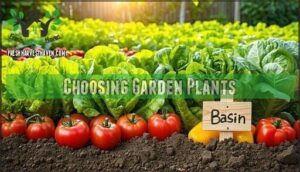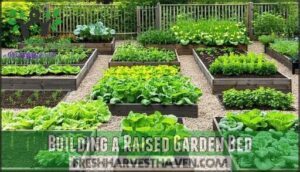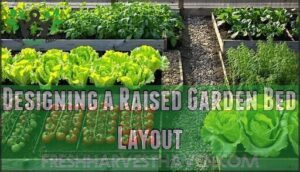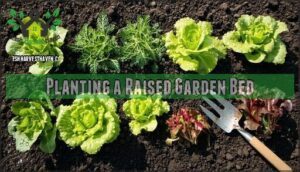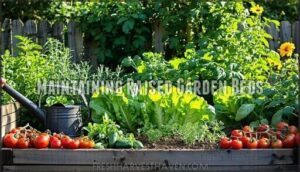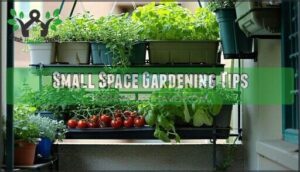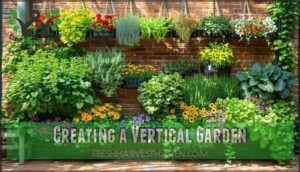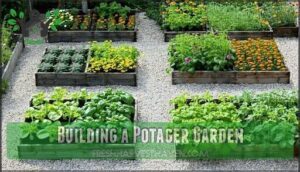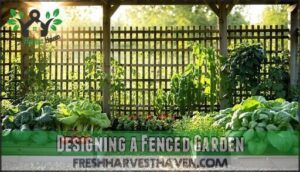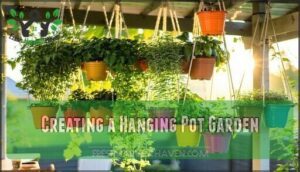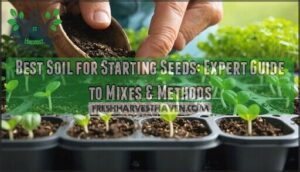This site is supported by our readers. We may earn a commission, at no cost to you, if you purchase through links.
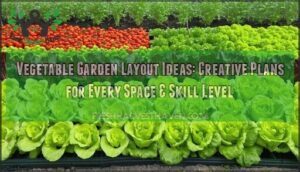 When you explore vegetable garden layout ideas, you’ll find that a few clever tricks help you squeeze a bumper crop out of any space.
When you explore vegetable garden layout ideas, you’ll find that a few clever tricks help you squeeze a bumper crop out of any space.
Go with classic rows, tidy raised beds, or try square foot gardening for top efficiency.
Plant taller veggies—think tomatoes or corn—at the back to soak up sun, and tuck quick growers like lettuce up front.
Pair up friends like carrots with onions for healthy, bug-free beds.
Whether you’re working a corner of the backyard or lining a balcony, a thoughtful design means less weeding, more harvest.
Next up: discover smart ways to match plants with your space.
Table Of Contents
- Key Takeaways
- Garden Layout Basics
- Choosing Garden Plants
- Raised Garden Bed Ideas
- Small Space Gardening Tips
- Unique Garden Designs
- Frequently Asked Questions (FAQs)
- How do you design a vegetable garden?
- How to create a simple plan for veggie gardening?
- What is a vegetable garden layout?
- Which vegetables grow well together chart?
- Which vegetables should not be planted next to each other?
- What is the best path for a vegetable garden?
- Which vegetables should be planted together?
- How do I map my vegetable garden?
- What vegetables should not be planted next to each other?
- How do I layout my vegetable garden?
- Conclusion
Key Takeaways
- Pick a garden layout—like raised beds, square foot, or vertical—to match your space and goals for the most efficient use.
- Arrange taller crops in the back, shorter ones in front, and pair companion plants to boost growth and cut down on pests.
- Use compact varieties, vertical supports, and smart spacing to make the most of small spaces or containers.
- Plan paths wide enough for easy access and don’t crowd plants—this keeps maintenance simple and your harvest healthy.
Garden Layout Basics
Getting your garden layout right sets the foundation for healthy plants and efficient use of space.
You’ll want to choose a method, like square foot, raised bed, backyard, or kitchen layouts, that matches your available area and goals.
Square Foot Gardening Methods
Picture a 4×4-foot raised bed divided into a grid design—each square hosts different crops.
This square foot gardening method maximizes efficient space utilization by optimizing plant spacing and matching soil mix to each plant type.
Add vertical supports for tall growers and simple pest control tricks.
Companion planting techniques can further enhance growth and deter pests.
These vegetable garden layout ideas deliver tidy rows, reduced weeding, and impressive yields.
Raised Bed Gardening Layouts
At the root of effective vegetable garden layout is the raised bed. Choose sturdy bed materials and focus on soil composition for strong growth.
Raised beds promote better drainage solutions and make pest control easier—think of it as building a fortress for your plants.
Swap crops each season for crop rotation, keeping your garden design productive and your soil healthy year after year.
Backyard Garden Layouts
Balancing a backyard garden means blending design elements like Family-Friendly Gardens, Play Area Integration, and Pet Protection.
Backyard gardens thrive when play, pets, and family-friendly features come together in one vibrant, growing space.
Plan your vegetable garden so it’s both productive and resilient—think Relaxation Zones alongside sturdy beds or fences.
Smart garden layout lets everyone enjoy the outdoors while your crops stay safe, proving that a backyard garden can truly serve every household need, making it a backyard garden.
Kitchen Garden Layouts
You’ve got the backyard sorted, but let’s talk kitchen gardens—a culinary garden set just outside your door.
Smart garden layout keeps most-used herbs, salad greens, and gourmet vegetables within arm’s reach.
Try an herb spiral or edge beds with edible flowers.
This garden design blends beauty and purpose, making your vegetable garden layout both practical and rewarding.
Choosing Garden Plants
Choosing the right plants for your vegetable garden depends on your local climate, available space, and what you want to grow for your table.
You’ll find it’s easier to plan a successful layout when you consider plant spacing, sun needs, and which crops work well side by side, including the idea of complete concepts.
Selecting Vegetables for Climate
Once you’ve picked your vegetable garden layout, focus on crop selection tied to your Climate Zones.
Pay close attention to Frost Dates—some vegetables bolt at the first chill, others thrive with more heat tolerance.
Explore regional varieties and don’t overlook microclimates in your yard.
Smart garden planning means choosing vegetable varieties that fit your conditions, boosting both yield and healthy plants.
Companion Planting Strategies
Dive into companion planting to boost your vegetable garden layout.
By pairing the right crops, you’ll strengthen Pest Deterrents, enhance Soil Health, and discover Flavor Enhancement.
Smart garden design supports successful garden planning—just look for these winning combos:
- Tomatoes with basil for Growth Support
- Carrots with onions as natural Pest Deterrents
- Marigolds dotted throughout for Space Optimization
Planting for Small Spaces
When you move from companion planting to a small-space gardening strategy, focus is everything.
Use Dwarf Varieties and Intensive Planting to squeeze maximum flavor from tight spots.
Succession Planting keeps the harvest rolling.
Vertical Structures and smart Container Choices turn a cramped plot or container garden into a productive vegetable garden.
Here’s a quick cheat sheet:
| Tactic | Application |
|---|---|
| Dwarf Varieties | Small garden |
| Vertical Structures | Container garden |
Vegetable Pairing Tips
When planning your vegetable garden layout, keep companion planting in mind for smart Flavor Combinations and efficient use of Space Requirements.
Pair herbs like basil with tomatoes to enhance flavor and pest control. Align vegetable growth with Growth Habits, allowing taller crops to shield delicate plants.
Match Nutrient Needs for robust harvests, and use thoughtful plant spacing to maximize your garden’s success.
Starting with easy-to-grow vegetables can increase your chances of a successful first harvest.
Raised Garden Bed Ideas
Raised garden beds give you control over soil quality and make gardening easier on your back, especially if bending isn’t your favorite chore.
Raised garden beds lift your harvest and your spirits, making gardening simple and comfortable for everyone.
You’ll find practical layout tips that help you grow more vegetables in less space, no matter the size of your yard, and this can be particularly useful for achieving better results.
Building a Raised Garden Bed
After sorting garden plants, you’re ready to build your raised beds for the perfect vegetable garden.
Focus on these three things:
- Compare bed material choices for longevity and safety. Consider durable bed options for long-term use.
- Plan soil composition tips for healthy growth—mix compost, topsoil, and organic matter.
- Check height considerations and accessibility options to suit every gardener, making your garden layout and raised beds easier to manage.
Designing a Raised Garden Bed Layout
A well-designed raised bed layout feels like a winning playbook for your vegetable garden.
Get your bed dimensions right—4 feet wide lets you reach without trampling Soil Composition. Plan for good Plant Spacing and add a watering system to keep maintenance easy.
Consider accessibility options, especially for knee savers.
Here’s a quick layout guide:
| Feature | Recommendation |
|---|---|
| Bed Dimensions | 4′ x 8′, 6-12" high |
| Plant Spacing | Varies by vegetable |
| Accessibility | 2-3′ wide pathways |
Planting a Raised Garden Bed
From the ground up, success in planting a raised garden bed begins with matching plant spacing to each crop’s needs—don’t crowd the lettuce.
Select soil composition rich enough for robust vegetable cultivation, and situate the bed where sun exposure lasts most of the day.
Consider purchasing a bed to simplify the setup.
Smart watering techniques and strategic pest control shape healthy garden layouts and vibrant harvests in your vegetable garden design.
Maintaining Raised Garden Beds
A thriving vegetable garden starts with attentive raised bed upkeep. Focus on soil replenishment and garden maintenance for strong yields and healthy plants.
To keep your raised beds in peak condition, remember:
- Refresh garden soil and compost for superior soil quality.
- Use effective watering techniques for deep moisture.
- Practice weed prevention and regular pest control.
- Check structural integrity for sturdy, productive beds.
To enhance growth, consider companion planting strategies for superior soil quality and healthy plants.
Small Space Gardening Tips
When space is tight, you still can grow a productive vegetable garden by using smart layouts and vertical solutions.
Learn how to select plants and arrange containers to maximize every inch while keeping maintenance simple and efficient.
Creating a Small Garden Layout
Picture your small garden as a well-orchestrated symphony—every inch counts.
To maximize space, select compact vegetables and use vertical supports to boost layout efficiency. Prioritize sunlight considerations and soil health for strong results.
Smart garden design is all about clever arrangement, not cramming.
Below’s a simple guide in table form to get you started:
| Maximize Space | Sunlight Considerations | Layout Efficiency |
|---|---|---|
| Vertical stakes | Track daily sun | Zig-zag rows |
| Stack containers | Plant shade lovers low | Group by height |
| Trellis beans | Rotate crops yearly | Pathways mulched |
Choosing Vegetables for Small Gardens
In a small garden, aim for Compact Varieties and High Yield selections—think lettuce, bush beans, or cherry tomatoes.
Quick Growers let you harvest more often. Succession Planting keeps your vegetable garden productive.
Arrange compact vegetables close together in your garden layout, maximizing every inch. Investing in Space Saving picks makes a small garden feel surprisingly big with diverse garden vegetables, using High Yield selections.
Vertical Gardening Techniques
With vertical gardening techniques, you can transform blank fences into Living Walls or use a smart Trellis Design for climbing plants.
Try Gutter Gardens for lettuce or Hanging Planters for strawberries—pallet gardens work wonders, too.
These ideas fit any vegetable garden or tight space, streamlining garden layouts for small-space gardening while making the most of every inch you’ve got.
Container Gardening Options
If you’re already stacking your greens with vertical gardening, containers make the next logical step in small garden design.
Choose the right potting soil types, because drainage makes a huge difference. Container size matters—tomatoes need more room than herbs.
Place your small garden where it meets sunlight requirements, stick to reliable watering techniques, and follow consistent fertilizing schedules for lush results in container gardening layouts.
Consider growing berries, as strawberries thrive easily in containers.
Unique Garden Designs
You can use unique garden designs to make the most of any space, whether you choose vertical gardening, a potager, or hanging pots.
With a clear plan, it’s easy to combine practicality and style for a productive vegetable garden.
Creating a Vertical Garden
With clever Trellis Selection and sturdy Panel Materials, you’ll give your vertical garden the backbone it needs for climbing support and true space maximization.
Hanging Baskets and Wall Planters bring smallspace gardening to life, letting you experiment with garden layouts that fit tight corners.
Consider various panel options for your trellis. Embrace unique garden design—those walls are valuable real estate waiting for green layers.
Building a Potager Garden
Your kitchen’s just steps away from harvesting fresh basil or edible flowers when you try a potager garden.
Potager aesthetics blend classic design principles with practical planting—raised beds and defined paths create tidy, attractive garden layouts.
Thoughtful garden plans that focus on Kitchen Proximity and Continuous Harvest let you enjoy both beauty and productivity in your vegetable garden layout.
Designing a Fenced Garden
A sturdy garden fence turns your vegetable patch into a fortress with style.
Consider fence material, cost analysis, and how garden security shapes your overall garden design.
For foolproof garden layouts, focus on:
- Choosing fence material (wood, wire, vinyl) for durability.
- Prioritizing pest control by sealing gaps.
- Balancing design aesthetics with smart garden plans.
Creating a Hanging Pot Garden
Once your fenced garden brings a sense of order, try adding height with a hanging pot garden.
Hanging baskets and garden containers let you grow hanging herbs and compact veggies, even on a patio.
Pick sturdy pots, check sunlight needs, and use slow-release watering techniques.
Tackle pest control early, and weave containers into your vegetable garden layout for a thoughtful, efficient garden design.
Frequently Asked Questions (FAQs)
How do you design a vegetable garden?
Picture yourself drawing straight lines in dirt like it’s the world’s slowest tic-tac-toe.
Start by mapping sunlight, then build raised beds or neat rows, spacing crops for airflow, easy watering, and—believe it or not—actual harvests.
How to create a simple plan for veggie gardening?
Start by measuring your space and noting sunlight patterns.
Draw simple rectangles for beds, then list what you’ll grow.
Group plants by height or needs.
Add paths for access—like leaving breadcrumbs, future-you will be grateful, and note that this step is about access, and how it helps future-you.
What is a vegetable garden layout?
A vegetable garden layout is your map for where every plant goes.
You organize beds, rows, or containers so crops get sunlight, space, and easy access.
It’s all about planning for healthy growth and easy harvesting.
Which vegetables grow well together chart?
Imagine planting tomatoes and basil together—they boost each other’s growth and repel pests.
Use a companion planting chart: pair carrots with onions, beans with corn, and squash with nasturtiums.
You’ll create a supportive, thriving ecosystem.
Which vegetables should not be planted next to each other?
Don’t plant beans near onions or garlic, as they stunt each other’s growth.
Keep tomatoes away from corn and potatoes to avoid pests and diseases.
Lettuce dislikes parsley, and carrots shouldn’t mingle with dill or fennel.
What is the best path for a vegetable garden?
Wide, sturdy paths keep your shoes mud-free and plants safe.
Leave 2-3 feet between beds for easy walking, wheelbarrow turns, and kneeling.
Gravel, mulch, or stepping stones work best—no one likes tripping over tangled weeds, and this helps maintain a safe and mud-free environment.
Which vegetables should be planted together?
Think it’s hard to pair crops? It’s not.
Beans boost corn and squash yields, basil improves tomatoes, and marigolds deter pests from everything.
Mix quick growers, like radishes, with slow ones—your garden’s teamwork will shine.
How do I map my vegetable garden?
Start by drawing your garden to scale, marking sun patterns and water sources.
Group veggies by height and needs, then leave wide enough paths for easy harvest.
Plan for companion planting and rotate crops next season.
What vegetables should not be planted next to each other?
Tomatoes and corn squabble over nutrients, while onions can stunt beans’ growth.
Onions and peas clash, too.
Keep potatoes away from squash to dodge pest problems. Give each veggie the right neighbor—your garden will thank you, as this helps to dodge pest problems and ensures each veggie has the right neighbor.
How do I layout my vegetable garden?
Group vegetables by height—tall in back, short in front.
Arrange by sun needs and space, then add pathways two feet wide for easy access.
Keep quick-harvest crops close for fast grabs, and companion plant for healthier beds.
Conclusion
Imagine the possibilities that await as you put these vegetable garden layout ideas to work.
By matching plants with your conditions—backyard, balcony, or compact corner—you’ll maximize yields and minimize chores.
Whether you choose classic rows, raised beds, or experiment with vertical gardening, your space transforms into a productive haven.
Don’t forget the impact of companion planting and plant selection, with the right layout, a healthier, more abundant harvest is just a season away.
Start planning your garden today.
- https://northerngardener.org/maximize-veggie-garden-production/
- https://ngb.org/raised-bed-gardening-benefits/
- https://www.thespruce.com/companion-planting-with-chart-5025124
- https://www.gardeners.com/how-to/small-space-vegetable-garden/8766.html
- https://ucanr.edu/statewide-program/uc-master-gardener-program/efficient-use-space

